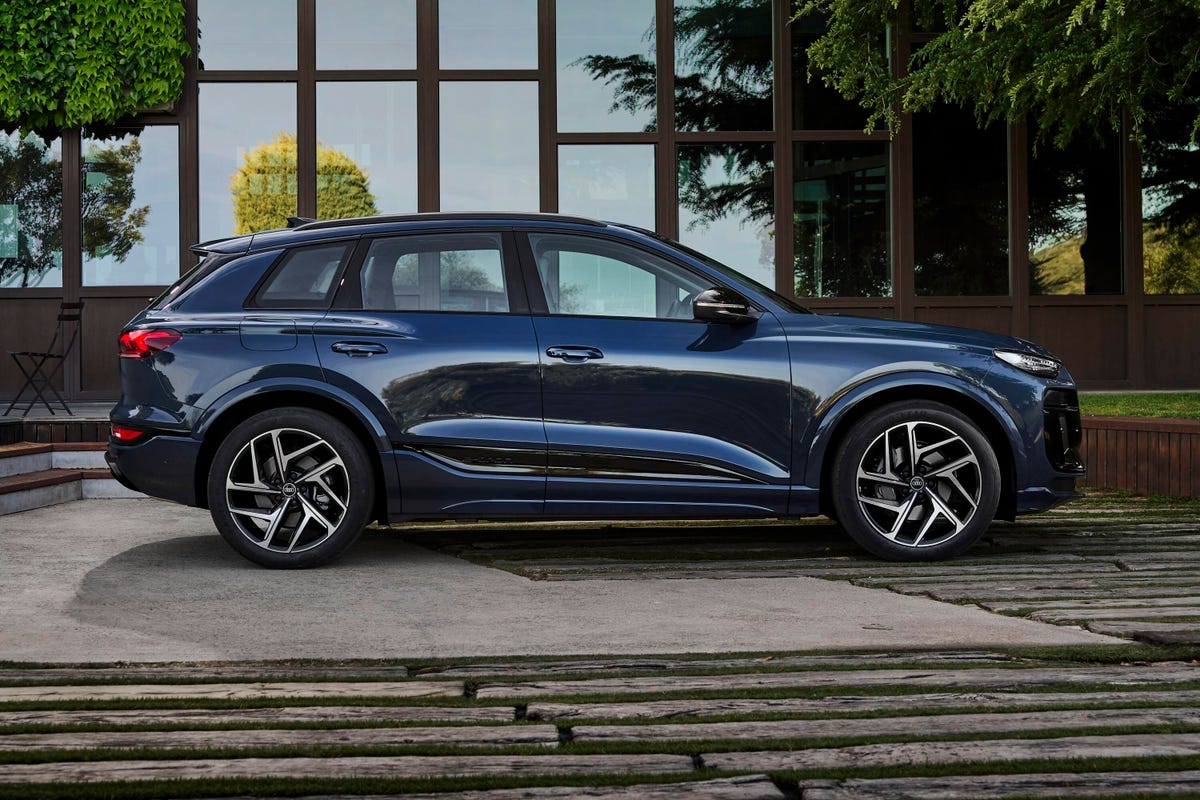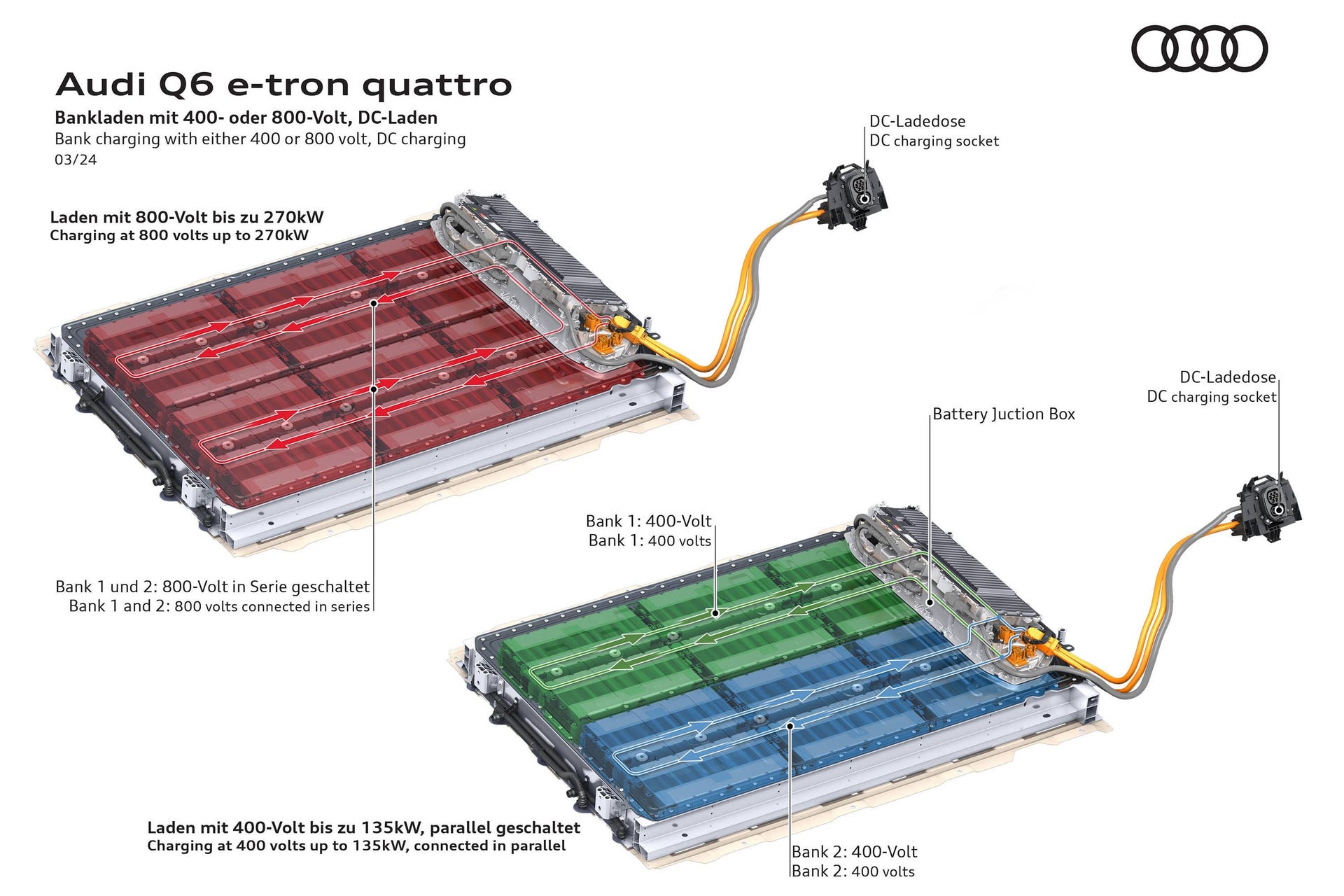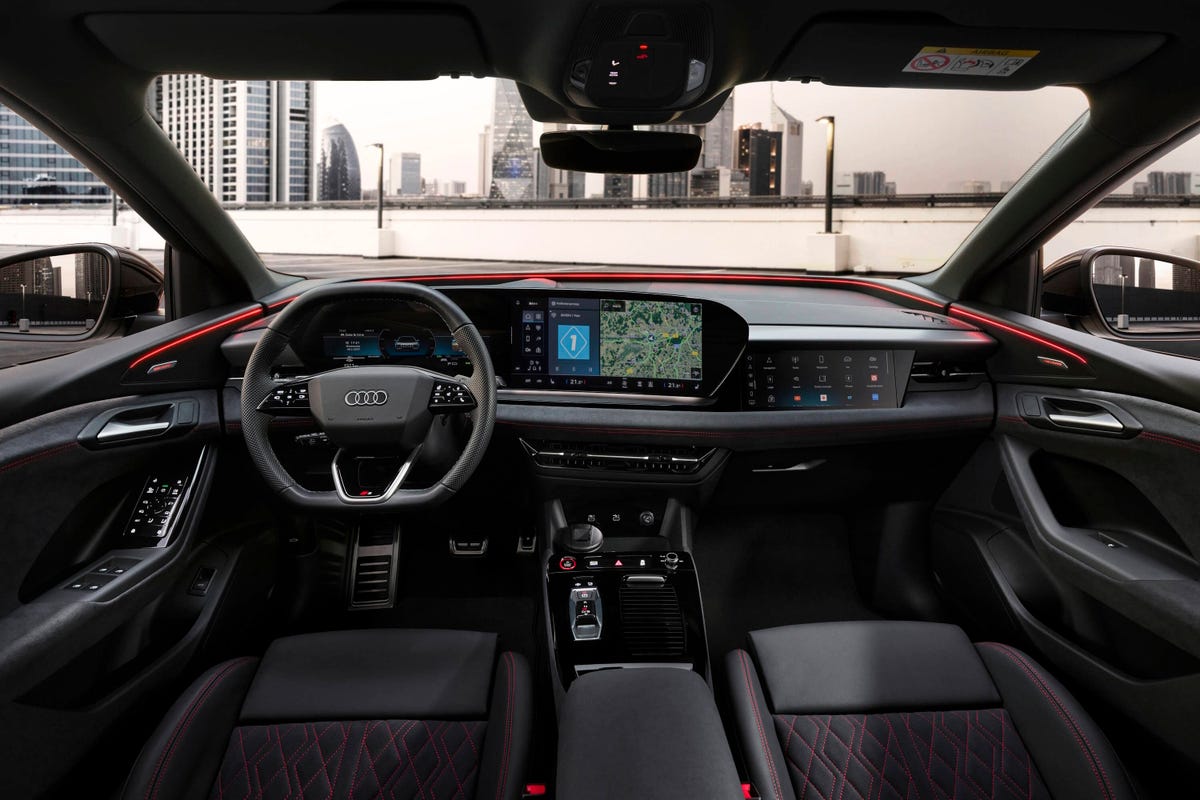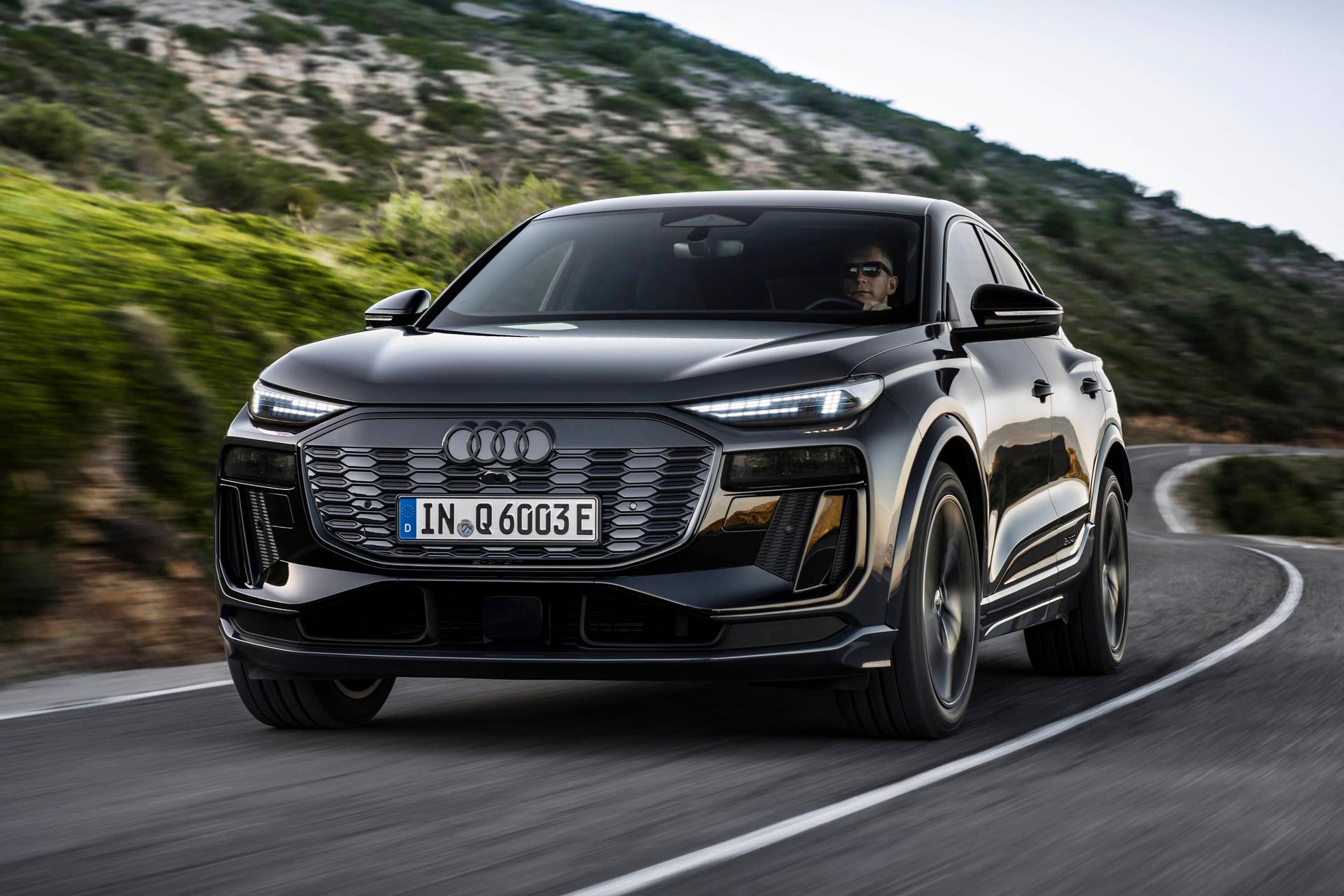The Tesla Model Y’s success as 2023’s best selling car globally proves what we already know: Midsize premium SUVs are so hot right now (especially in America) and many shoppers in the class are both curious about and ready to make the EV conversion. The new Audi Q6 e-tron and its sport-tuned SQ6 variant are shots aimed at the heart of this highly competitive segment, marking their debut with a salvo of new technologies.
The Q6 is the first Audi model built on the new PPE electric vehicle platform shared with Porsche’s upcoming Macan EV, boasting faster charging and improved efficiency. The EV fills its dashboard with the latest generation of the automaker’s tech and trio of OLED displays powered by Android and AI. Even the taillights break new ground with unique features that boost safety and style. Audi has pulled out all of the stops for what could be the most important model in its battery-powered lineup and a critical step on the brand’s path to full electrification.
Slotting into Audi’s e-tron family between the three-row Audi Q8 e-tron and the compact Q4 e-tron, the Q6 measures 187.8 inches long with a 114.1 inch wheelbase — scaled to precisely compete with the Model Y and serve as a premium alternative to other midsize EV SUVs like the VW ID 4, Ford Mustang Mach-E and Kia’s EV6. You’ll find around 18.6 cubic feet of cargo space behind the power lift gate. Up front, an additional 2.2 cubic feet of frunk storage accommodates a small carry-on size bag or the charging cable. Inside, a spacious cabin boasts room for five passengers with a flat, hump-free floor. Audi also claims over 2 tons (US) of towing capability for the midsize e-tron SUV.
EV performance and range
Underpinning the Q6 e-tron is the Volkswagen Group’s new Premium Platform Electric architecture, which is shared with the upcoming Porsche Macan EV. At launch, the SUV will be offered in two specs — Q6 and SQ6 — each with dual-motor all-wheel drive. The front motor is an asynchronous (ASM) unit that provides on-demand torque to the front axle as needed, while the rear permanent magnet (PSM) motor is a bit more powerful and serves full time. Both motors have been designed to use fewer heavy rare earth metals in their construction and identical diameters for their rotors and stators, which allows them to share many components, saving cost and complexity. One notable shared component is each motor’s self-contained dry sump lubrication and cooling system — inspired by motorsports combustion engines — which injects oil directly onto the e-motors’ rotating components to improve thermal performance, efficiency and, ultimately, range.

Enlarge Image

When connected to a lower voltage DC fast charger, the Q6 e-tron’s 800-volt battery can split into two 400-volt banks.
One thing that I’ve always loved about Audi’s e-tron models is that they’re available with dual charging ports, which can now be found on the rear fenders of the Q6 where they allow a bit more flexibility when parking and charging at home and destination chargers. On the driver’s side, the CCS combo port accommodates the DC fast charging and AC Level 1 and Level 2 charging. The passenger side port is AC only, accepting up to 9.6 kW/40A on North American single-phase 240-volt power. Though Audi has committed to switching to the NACS standard, the Q6 e-tron will not feature the “Tesla port” at launch.
Like most EVs, the Q6 is also able to recharge itself with recaptured braking energy. There are now five user-selectable regeneration modes, including a new one-pedal driving mode that engages full regen when the accelerator is lifted and can bring the SUV to a stop without touching the brake pedal. All modes offer up to 220 kW of recuperation — reclaiming up to 95% of braking energy with each stop — automatically balancing friction brakes with the regeneration as needed.
Active OLED technology
This wouldn’t be an Audi debut without a new lighting technology that’s too advanced for our vehicle regulations here in the States. The new Q6 e-tron debuts new generation LED and OLED technology. Up front, the daytime running lights feature 61 white LED segments each, while the rear lights share 360 triangular digital OLED segments that can display animated sequences that greet the driver when approaching or locking the vehicle. This feature also powers 11 user-selectable themes that customize the look and shape of the SUV’s light signature. One theme even features animations that play while driving, using an algorithm to ensure that the overall light output of the animation remains constant to reduce distraction to other drivers. US regulations prevent the use of moving lights on passenger cars, so we’ll get only the static themes.
The next-generation OLED Matrix rear lights feature user selectable themes and driver aid iconography.
Beyond just looking cool, Audi is thinking of ways to use its lighting tech to improve safety. For example, when activating the hazard lights or when the automatic emergency braking system is triggered, the OLED taillights reshape to form a triangle icon (similar to the shape on the button for most cars’ hazard lights) to warn other drivers of danger. Audi also demonstrated tail light configurations that notified pedestrians or other drivers that the Q6 was performing an automated parking maneuver or that a door was about to open into a bike lane. In all cases, the effect is subtle and doesn’t seem to affect visibility.
Audi Digital Stage
Settle in behind the wheel to be greeted by Audi’s new triple-display Digital Stage MMI infotainment suite. This setup mates a pair of flexible OLED displays — an 11.9-inch digital instrument cluster and a large 14.5-inch main touchscreen — to a single glass panel that curves around the steering wheel. The hardware runs the latest-generation of Audi’s Multimedia Interface (MMI) software, which is now based on Android Automotive OS. Though, without “Google Built-In,” users will use Audi’s own curated marketplace rather than Google Play Services to download apps like Spotify, PlugShare, YouTube or Beach Buggy Racing. (Video apps and games, by the way, will be restricted to use when parked and charging.)
Audi’s marketplace also enables downloadable “function on demand” features like improved surround sound processing or alternate light signature themes, which kind of sounds cool. However, mostly this opens the potential for microtransactions and paywalling features which, ultimately, I’m not super thrilled about.
Rounding out this triple screen rig is the 10.9-inch passenger display located on the far right of the dashboard. This is a fully featured infotainment interface that allows the front seat passenger to search for and send destination to the main navigation screen, select audio sources and more. Passengers can even view video sources, like YouTube, while the vehicle is in motion thanks to an Active Privacy Mode that prevents the driver from seeing or being distracted by the auxiliary screen.

Enlarge Image

The SQ6 e-tron’s more aggressive design and larger wheels are visual indicators of its increased power.
What’s next for the Audi Q6 e-tron?
Having checked the tech and taken the Q6 and SQ6 e-tron SUVs for very short first drives has left me excited for this new addition to the EV landscape and eager to spend more time behind the wheel, experience the performance under real-world conditions and see how Audi’s unique approach to dashboard tech shakes out on the road.
The first Audi Q6 e-trons will begin reaching European customers this summer with orders opening this month (March 2024) starting at 74,700 euros (around $81,203). North American prices will almost certainly be significantly lower to slot in between the smaller Q4 ($56,395) and larger Q8 ($75,595) e-tron models, but final MSRP hasn’t been announced. Expect to learn more when reservations open in the coming weeks at AudiUSA.com.
Post-launch, Audi expects to add Sportback variations and two rear-wheel drive configurations to the mix (one long range model and an entry-level spec that I reckon will use a smaller 83 kWh battery pack.) When asked whether we’ll eventually see an even hotter-trotting RS Q6 e-tron variant, representatives of the automaker refused to confirm beyond knowing smiles.


